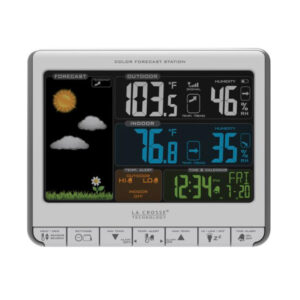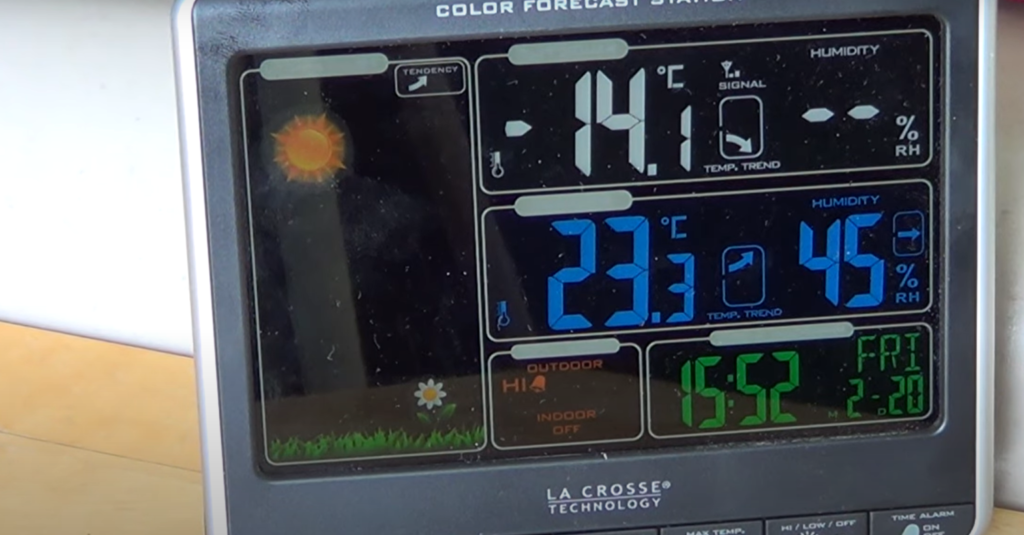A weather station is an important tool to have in order to keep track of the ever-changing weather conditions. If you are in the market for a quality weather station, the Wireless Weather Station from La Crosse Technology 308-1412S is a great option. This guide will answer some of the most common questions about this product, as well as provide some useful tips on how to get the most out of your new wireless weather station.
Table of Contents
Wireless Weather Station from La Crosse Technology 308-1412S
 Take the weather report with you wherever you go with this Wireless Weather Station from La Crosse Technology. This handy device is equipped with a colored LCD that you can adjust to your desired brightness, as well as temperature trend indicators so you can always be prepared for whatever the forecast has in store.
Take the weather report with you wherever you go with this Wireless Weather Station from La Crosse Technology. This handy device is equipped with a colored LCD that you can adjust to your desired brightness, as well as temperature trend indicators so you can always be prepared for whatever the forecast has in store.
And last but not least, the Wireless Weather Station comes complete with a calendar-data and time display so you can keep track of all your appointments.
Pros and Cons of La Crosse Technology 308-1412S
PDF Manual for La Crosse Technology 308-1412S
Buyer’s guide
Important Factors to Consider When Buying a Home Weather Station
There are a few factors you should take into consideration before purchasing your own home weather station. The type of climate you live in, the features you need, and your budget are all important things to think about.
Purpose and Sensor Requirements
The first thing you need to consider is what you plan to use your weather station for. Are you looking for a simple device that will just tell you the temperature and humidity? Or do you want something more sophisticated that will track data over time, provide detailed information about atmospheric conditions, and even allow you to control your home’s heating and cooling system?

The sensor requirements of the device should also be considered before making a purchase.
Consider where you will place the sensors too. Will they be placed outside where they are exposed to the elements? Make sure the sensors can direct sunlight, high winds, and heavy rains [1].
Accuracy and Reporting Frequency
Of course, you will also want to consider accuracy when choosing a home weather station. All devices have some margin of error, but you’ll want to make sure the one you choose meets your standards.
The reporting frequency is another important factor to consider. Most weather stations will give you updates every few seconds, but there are some that only update every few minutes. If real-time data is important to you, make sure the device you select can provide it.
Finally, take a look at the display. How easy is it to read? Does it show all the information you want? Is it backlit so you can see it in the dark?
Transmission Distance and Power Requirements
The transmission distance is the next thing you need to think about.

Power requirements are also an important factor to consider. Some weather stations require batteries while others need to be plugged into an outlet. If you want a completely wireless system, make sure the one you choose doesn’t need any cords.
Internet Connectivity and Smart Home Features
Nowadays, many weather stations come with internet connectivity and smart home features. If you want to be able to access your device from anywhere in the world or control it with your voice, make sure the one you select has these capabilities.
The internet connectivity is provided by a built-in WiFi module. The smart home features, on the other hand, are enabled by adding a compatible smart home hub.
Keep these factors in mind when shopping for your own home weather station and you’ll be sure to find the perfect device for your needs.
Solar Power and Portability
If you want a weather station that is completely independent of the power grid, then you should look for one that is solar powered. These devices use solar panels to recharge the batteries, so you don’t have to worry about plugs or cords.

Portability is another important factor to consider if you plan on taking your weather station with you when you travel. Many of these devices are small enough to fit in your suitcase or backpack, but make sure the one you choose doesn’t weigh too much [2].
Upgrade Options
You should also consider the upgrade options when choosing a home weather station. If you think you might want to add additional sensors or expand the system in the future, make sure the device you select has that capability.
You can add extra sensors to most weather stations, but not all of them have the same expandability. Some devices only allow for a few additional sensors while others can accommodate dozens.
Durability
This model of the weather station from La Crosse Technology is made of plastic and it is not waterproof.
If you are looking for a weather station that can withstand the elements, you should look for one that is made of stainless steel or another durable material. You should also make sure the device you select is rated for outdoor use.
Where Is the Best Location to Install a Personal Weather Station?
There are a few things you’ll want to consider when deciding where to install your personal weather station. First, you’ll want to make sure that it is in a location that is not obstructed by trees, buildings, or other objects. Second, you’ll want to make sure that the station is level.

Third, you’ll want to make sure that the station is far enough away from any sources of heat or cold so as not to skew the readings. Finally, you’ll want to make sure that the station has a clear view of the sky [3].
FAQ
Is a home weather station worth it?
A home weather station can be a great addition to your home, providing you with accurate and up-to-date information about the local weather conditions. It can also be a great conversation starter, helping you to bond with friends and family over your shared interest in the weather.
This smart device can be used by practically anyone to monitor the indoor and outdoor temperature, humidity, wind speed, and rainfall. It also features a color LCD display, allowing you to view all of this information at a glance.
How do I choose a home weather station?
There are a few things to consider when choosing a home weather station, such as the accuracy of the sensors, the type of display, and the level of customer support.
Accuracy is important if you want to use your home weather station to make decisions about whether or not to go outside. The last thing you want is to be caught in a rainstorm because your weather station said it was sunny!
The type of display is also important. Some people prefer a digital display, while others prefer an analog one. You should also consider how easy it is to read the display in different lighting conditions.
Where are La Crosse weather stations made?
La Crosse weather stations are made in the United States. The company has a long history of manufacturing high-quality products, and their weather stations are no exception. Among products of this company are also popular atomic clocks, which are known for their accuracy.
Related Video: La Crosse Technology 308-1412S
Conclusion Paragraph
This model of wireless weather station is a good choice for those who want an accurate and reliable device without spending a lot of money. It is also a good choice for those who want to avoid the hassle of setting up a weather station with wires. The La Crosse Technology 308-1412S wireless weather station is easy to set up and use, and it provides accurate information that can be used to make decisions about your daily activities.
References:
- https://www.weatherstationadvisor.com/
- https://solartechadvisor.com/solar-powered-weather-station/
- https://www.weathershop.co.uk/news/installing-a-weather-station






Leave a Reply